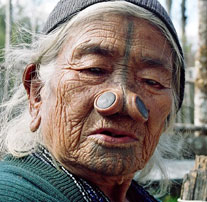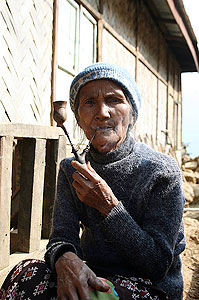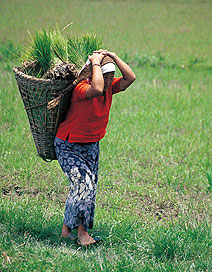|
|
|
Mizoram People |
|
|
About People of Mizoram
The people of Mizoram are known as Mizos. The term 'Mizo'
is made of two words, mainly Mi and Zo. 'Mi' means
people and 'Zo' means Hill. Thus Mizo means "hill
people" and gives them a racial and distinctive ethnic
identity. This collective name was given by their
neighbours to a number of tribes which settled in the
area. The Mizos are simple, literate, happy, carefree,
contented, generous, social, hospitable, fun loving and
freedom-loving people. They lead a life of close
friendship in their place with pleasant climate and
dense green forests abounding in diverse flora and
fauna. The Mizos are known as the songbird of the North
east and considered to be one of the finest choir
singers in North east India. |
 |
|
|
|
|
The Mizos do
not consider any difference between men and women who rank
equal in their society. Ninety percent of them are cultivators
and a village exists like a big family. Birth of a child,
marriage in the village and death of a person in the village
or community feast arranged by a member of the village are
important occasions in which the whole village is involved.
Their guiding code of ethics is known as "Tlawmngaihna", which
means that everyone should be unselfish, hospitable, kind and
helpful towards each other. "Tlawmngaina" to a Mizo means that
compelling moral force which finds expression in
self-sacrifice for the service of others. The Mizos are
blessed with a rich culture and beautiful environment and love
to dance and sing. They have a rich variety of community
dances, which have been handed down for generations. The
dances expresses the gay and carefree spirit of the Mizos.
These dances are not performed on stage, and have been evolved
for community involvement and participation. Every major Mizo
village now has an YMA (Young Mizo Association) centre,
dedicated to infuse society with its traditional lifestyle and
customs. They not only carried out their religious duties but
also introduced literacy which is very high in this state.
Their language adopted the Roman script. The different groups
of tribal people are thought to have originally come from
North west China who were gradually pushed southward towards
Tibet and Burma in the 7th century and finally reached their
present homeland less than 300 years ago. The remainder,
mainly nomadic Chakmas along the Western border, practise a
religion which combines Hinduism, Buddhism and animism. |
|
|
|
The
Mizos also believed that mountains, big trees, huge
rocks, swamps and caves were haunted by the spirits and
demons which caused suffering to human beings in their
own different ways. The Mizos still use 'Pathian', the
old belief to call the God. Under the British rule,
western missionaries brought about changes in the life
of the people from the 19th century. The Mizos were so
enchanted by their new faith in Christianity that their
entire social life, sense of values and thought
processes were transformed and guided by the
Missionaries directly or indirectly. The main aim of the
Missionaries were not directed at changing the basic
customs of the Mizo society. The great majority of the
self reliant and music loving Mizos are Christian
converts and have built up a strong tradition of Western
choral singing. The customs and traditions which they
found meaningless and harmful were abolished by
persistent preaching. Despite of external influences
which threatened Mizo culture during the turbulent
period after Indian independence, the Mizos tried to
continue with great enthusiasm and vigour. Although
Christianity brought about changes in the Mizo lifestyle
and outlook, but still some customary laws have stayed
on. The tea replaced ZU as a |
 |
|
|
popular drink
among the Mizos. The Zawlbuk was replaced by modern education.
Animal sacrifices on ceremonial occasions, which were once an
integral part of Mizo religious system, are now considered
anathema. But various customs and community traditions like
the payment of bride price were still continued and
encouraged. The dowry, known as thuam, that a girl gets for
her marriage from her parents is exclusively her own property.
However, a written 'will' formally executed, now confers woman
the right to inherit the family property. These changes are
now made in the traditional customary laws.
In the Mizos, property is
inherited by men. The family property is owned by the youngest
son although the father may leave shares to other sons, if he
desires. If a man has no sons, his property is inherited by
the next kin on the male side. If a man dies leaving a widow
and minor children, a male relation, who usually happens to be
a brother of the deceased takes charge of the family and looks
after the property until one of the sons comes of age. If no
such male relative is around, then the widow acts as a trustee
of her husband's property until his son or sons are old enough
to inherit it. However, although the youngest son of the
family is the natural or formal heir to his father under the
Mizo customary laws, but actually, the paternal property is
generally divided among all sons. The youngest of them gets a
preferential treatment in that he would get the first choice
of the articles, and he would get two shares of the cash in
case of one each for the other brothers. A daughter or a wife
can inherit property only if the deceased has no heir on the
male side.
|
|
|
|
A Mizo
lady wears the 'Puan' and is more fond of it than any
other dress. The Puan consists of a colorful and
breathtaking display of intricate designs. 'Puanchei' is
one of the most beautiful dress worn by the Mizo girls.
This is worn on weddings and festivals such as Chapchar
Kut and Pawl Kut. In earlier times, these were all hand
woven but nowadays these are mostly machine made. They
are made from cotton and the colors are made by a thing
called 'Ting'. Along with this, a blouse which is of the
same pattern is usually worn. Ngotekherh is worn in all
festivals such as 'Chapchar Kut', 'Mim Kut' and 'Pawl
Kut'. The colours used in this cloth are black and
white. These are also hand woven and are made of cotton.
The black portion of the handloom is made from some kind
of an artificial fur.
Puandum
is one of the most important traditional handloom of the
Mizos. These are made from cotton and are handmade.
Puandum is wrapped over the shoulders while performing 'Khuallam',
one of |
 |
|
|
the famous
traditional dances of the Mizos. A Puandum consists of black,
red, yellow and green stripes. Puandum is an indispensable
item which every girl has to take along with her when she gets
married. It is used to cover her husband's body when he dies.
This is an integral part of the Mizo marriage and failure to
bring the cloth entails punishment leading to a reduction in
the bride price. Hmaram, also known as 'Kawkpui zikzial' is
mostly worn by the children and girls. They are worn on the
occasions such as 'Chawn Day', 'Chhawnghnawh Day' and 'Chapchar
Kut'. Kawrchei is worn on every 'kut' such as 'Chapchar Kut',
'Mim Kut' and 'Pawl Kut'. It is one of the most beautiful
blouses worn by the girls. These clothes are hand-woven and
are made from cotton. This are usually worn along with 'Puanchei'
and while performing the various dances of the Mizos. |
|
|
|
|
|
|
|
|
|
|
|
|
|